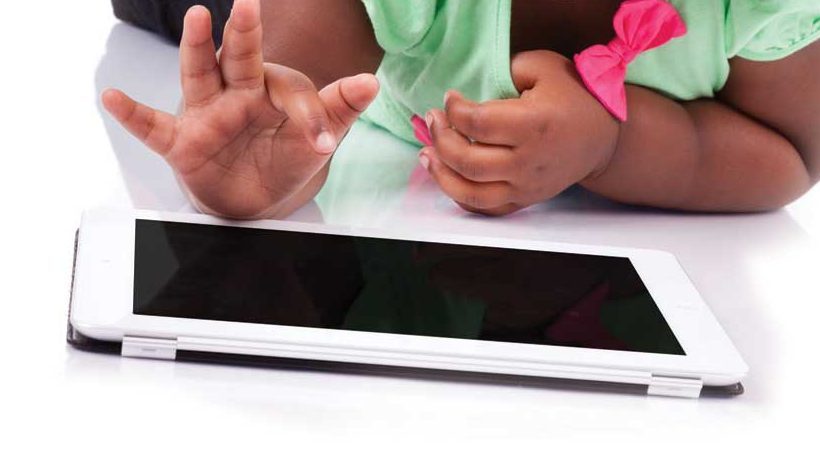There is a popular YouTube video where an adorable baby is playing with an iPad, then someone hands her a magazine. She pushes at the magazine and moves her fingers in a futile effort to get the pictures to change. Then, it’s back to the tablet where images are colorful, vivid and moving. The type across the screen reads “For my 1-year-old daughter, a magazine is an iPad that doesn’t work.”
Welcome to the kiddie-tech generation. Those born in the last two decades can’t really imagine a life without technology. Since the 1980s, computers have come into the home, and now it’s unusual not to own at least one. The iPad was launched in 2010, Facebook (with one billion users today) in 2004, the Nintendo Wii in 2006.
Stroll through the mall, get on a train or an airplane, or look in a mini van and you will see the youngest generation plugged in. It might be preschoolers sitting at a table at the Apple Store playing a game, a mom on the train keeping her toddler amused with her smart phone, or kids walking out of area middle schools with music plugged in their ears, strolling as they play a video game or rushing home to flip open a laptop.
Not all experts or studies agree on whether technology is a positive or a negative for children, but no one doubts that its use is on the upswing. In 2010, the Kaiser Family Foundation conducted a study that showed school-age children spent an average of 7.5 hours a day viewing some type of screen, including a computer, television, video game or smart phone. The study found an increase of more than an hour of daily viewing time, compared to a similar study conducted in 2005.


“The AAP recommends that parents establish screen-free zones at home by making sure there are no televisions, computers or video games in children’s bedrooms, and by turning off the TV during dinner,” according to its report on media use. “Children and teens should engage with entertainment media for no more than one or two hours per day, and that should be high-quality content. It is important for kids to spend time on outdoor play, reading, hobbies and using their imaginations in free play.”
Heavy technology use and television watching have been linked to sleeping and eating disorders, obesity, troubles at school, and attention issues, according to studies cited by the AAP.
“Students’ writing is suffering due to a lack of reading and a lack of patience,” explains Alison Shapiro, who teaches gifted and talented students and lives in Cherry Hill. Shapiro also works with area high school students on college essays and applications. While she still sees some brilliant writing, she also sees students accustomed to lightning-fast Internet responses and disinterested in spending the time meticulous work requires. “They want to do it now,” she says. “They want the CliffsNotes version of the books and of the writing. It’s an issue of patience. They don’t want to take the time for story development. I say, ‘This is your first draft, we have many more drafts to go.’”
In her own home, Shapiro and her husband take their boys’ (ages 11 and 14) electronics into their bedroom at night to charge, and they are returned in the morning. “I don’t want them texting at midnight,” she says. “Every family has to make those decisions on their own.”
Shawna Bu Shell, EdD, an assistant professor of teacher education and educational technology at Rowan University, sees the need for parents to take the controls at home and make the decisions on screen use and technology time.


She advises that when students are using a laptop or tablet to do homework, parents set goals and time limits. For example, if your child is doing a report on animals in Antarctica, ask them for an update on their progress after 30 or 40 minutes. Request a list of facts they have found or to see the pictures they have gathered online.
“Most parents don’t spend quality time when it comes to school work,” she says. “Have the child print out 10 to 15 images and discuss them with you. The computer is supposed to be a tool like a pencil. I wouldn’t give a 2-year-old a pencil and walk away.”
Bu Shell instructs teachers to integrate technology into the classroom, to teach while using the technology, not letting it teach for them. “I ask teachers to integrate it into their teaching, and parents should integrate it into their lives.”
Often parents who are less technology-savvy than their children worry about how to control Internet use and how to monitor something they themselves don’t completely understand.
“Parents fear they won’t be able to share pleasant childhood toys with their children, and technology will eradicate what parents value from their childhood,” says Ellen Malvern, a doctoral student in the Childhood Studies Department at Rutgers-Camden. She is researching play and technology, parents’ views and fears, and how advertising portrays technology versus how children actually use it.
“This should not be a threat,” she says. “Technology can be integrated with your experiences. Technology use can be physically isolating, but it can also be very socially stimulating.” Even though a child may not be physically close to a friend who has moved or relatives, they can keep in touch through electronic communication.
“Some fears are legitimate,” she says. “There are two sides to everything. Sometimes the Internet is opening doors parents would rather keep shut.” Malvern believes that like movies and books, what children see on the Internet can be an opportunity for meaningful conversation in households. “There is a benefit to having open discussions.”
Some studies show technology decreases outdoor play, but other studies conflict with that data, Malvern says. “Parents should decide what limits to put on technology. There are concerns it’s becoming a digital pacifier. Parents need to get creative. Engage the technology with them. Tech-nology can open up doors for children. They can socialize with people around the world, and it can build interests.”
Believe it or not, parents of children born in the 1950s and ’60s also struggled with how much television they should allow. “Be willing to realize there were new technologies when you were young,” Malvern says.
Stacey Umland, a Haddonfield mother with a 4-year-old daughter and 8-year-old son, has a tablet, smart phone and computer, but at home there are strict time limits. “You have to be careful with the amount of screen time,” she says. She allows 20 minutes and makes sure her children play other games, read books and run outside.
“I am amazed at how many kids in restaurants are allowed to have their video games on,” she says. “There’s no communication. We can all fall victim to it and not be in the present moment with our children.”










